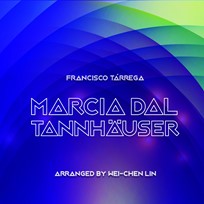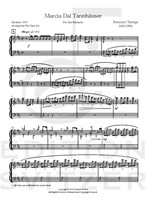
Marcia Dal Tannhäuser
Composer: Francisco Tárrega
Instrument: Marimba
Level: Advanced
Published: 2016
Price: €16.00
Item details
-
Description +
-
Arranged by Wei-Chen Lin
Duration: 6 min.
“Marcia Dal Tannhäuser” was arranged by Spanish guitarist and composer Francisco Tárrega (1852 - 1909) in an unknown year. The Marcia was excerpted from the second act of Wagner's opera. The purpose of this new arrangement is to exploit the rich acoustics and versatile colors of the marimba to evoke the grandeur of Wagner's orchestration. Advanced technique is required to showcase the character of the instrument.
-
-
Instrumentation +
-
Solo Marimba
-
-
Watch+
-
About the composer +
-
Francisco Tárrega was an important Spanish composer whose music and style of guitar playing became strongly influential in the twentieth century. He was central to reviving the guitar as a solo instrument in recital and concerts. Among his most popular compositions are Recuerdos de la Alhambra and Danza mora. He wrote nearly eighty original works for the guitar and over a hundred transcriptions, mostly of piano pieces by Chopin, Beethoven, and others.
Francisco Tárrega was born on November 21, 1852, in Villareal, Castellon, Spain. An accident in his early childhood permanently impaired his eyesight. He was taught his first lessons on guitar by Eugeni Ruiz, ironically a blind musician. In 1862, concert guitarist Julian Arcas, on tour in Castellon, heard young Francisco play and advised Tárrega's father to allow Francisco to come to Barcelona for study with him. Tárrega's father agreed, but insisted that he take piano lessons as well. His father was well aware that the guitar, as a solo vehicle, was in decline, coming increasingly to be viewed as an instrument to accompany singers, while the piano was all the rage throughout Europe.
By his early teens, Tárrega had become proficient on both instruments. For a time, he played with other musicians at local engagements to earn money, but eventually he returned home. In 1874 he enrolled at the Madrid Conservatory where he would study composition under Arrieta. He had brought along with him a recently-purchased guitar, made in Seville by Antonio Torres. Its superior sonic qualities inspired him both in his playing and in his view of the instrument's compositional potential. When Arrieta heard his student Tárrega in a guitar concert, he convinced him to focus on guitar and abandon ideas of a career involving the piano.
In about 1876, Tárrega began teaching and giving regular guitar concerts. He typically received much acclaim for his playing and began traveling to other areas of Spain to perform. By this time he was composing his first works for guitar. In 1880, he met his future wife, Maria Rizo, when he was giving a concert in Novelda. That same year he went on tour to Lyon, Paris, and London, now playing his own works in addition to those of other composers. In 1881, he and Maria were married in Novelda. He soon began transcribing piano works of Beethoven, Chopin, Mendelssohn, and others to enlarge his guitar repertory, and, no doubt, to make use of his considerable knowledge of keyboard music. Tárrega and his wife moved to Madrid, but after the death of an infant daughter, Maria Josefa, they settled permanently in Barcelona in 1885.
On a concert tour in Valencia shortly afterward, Tárrega met a wealthy widow, Conxa Martinez, who became a valuable patron to him. She allowed him and his family use of a house in Barcelona, where he would write the bulk of his most popular works, including Recuerdos de la Alhambra. From the latter 1880s up to 1903, Tárrega continued composing, but limited his concerts to Spain. In about 1902, he cut his fingernails and created a sound that would become typical of those guitarists associated with his school. The following year he launched a tour of Italy, giving highly successful concerts in Rome, Naples, and Milan.
In January 1906, he was afflicted with paralysis on his right side, and though he would eventually return to the concert stage, he never completely recovered. He finished his last work, Oremus, on December 2, 1909. He died 13 days later.
-
-
Reviews +
-
Review (Percussive Notes, June 2020)
New marimba literature seems to continue to fall from the sky, and with the constant deluge of pattern-based and technique-driven works readily available, it is refreshing to see a new perspective of an older work added to the repertoire. Francisco Tárrega, a Spanish guitarist living in the late 1800s, arranged an excerpt from Act II, Scene IV of Richard Wagner’s opera Tannhäuser, often known as the “Grand March.” Wei-Chen Lin arranged Tárrega’s piece to work for marimba. Lin wrote everything an octave higher than performed, so the piece can be played as written on a 4-octave instrument, or as performed and indicated in the score on a 5-octave marimba.
Tárrega’s own arrangement is more similar to works by Fernando Sor—also often performed on marimba—than something like “Asturias (Leyenda)” by pianist Albeniz but also transcribed for guitar by Tárrega and later Andrés Segovia. His interpretation of Wagner’s work takes more advantage of the various timbres inherent in the guitar to help represent the different voices of the orchestra, rather than using a more homogenous texture throughout and relying on technical flare for interest. Lin’s adaptation allows for a similar performance, although it will take a mature musician to bring out the right textures and voices throughout to make for an exciting presentation.
The marimba arrangement requires significant skill. Due to the nature of the guitar arrangement, the piece requires the ability to perform multiple layers at one time. Wei-Chen Lin’s performance on the publisher’s website is admirable, with a deft control over the marimba to demonstrate the versatility of his version. His ability to smoothly move across octaves, change intervals, and play fast, one-handed passages makes this an incredibly effective concert opener or closer. Because of these challenges, “Marcia Dal Tannhäuser” is not for the beginner or intermediate marimbist; but rather, at just under five minutes, a perfect piece for a graduate or professional recital. Listening to Wagner’s original and Tárrega’s arrangement will help a player truly understand the diverse nature of this piece and will provide the necessary information for a musical, engaging performance.
—Matthew Geiger
-
-
Credits +
-
Front Cover graphics and layout: Gaia Gomes
Engraving: Johan Svitzer
Printed in Copenhagen, Denmark
Copyright © Edition SVITZER
www.editionsvitzer.com
-




